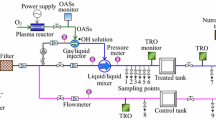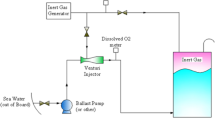Abstract
In order to verify the effectiveness of electrolytic treatment on ships’ ballast water, experiments are carried out by a pilot system in laboratory. The raw seawater and seawater with different concentrations of different algae are simulated as ships’ ballast water. The algae in the raw seawater can be killed if it is treated by electrolysis with an initial residual chlorine concentration of 5 mg/L. If the seawater with one kind of algae (Nitzschia closterum, Dicrateria spp., or Pyramidomonnas sp.105cells/mL) is treated by electrolysis with an initial residual chlorine concentration of 5 mg/L, the alga can be sterilized. If the seawater with one kind of algae (Dunaliella sp., Platymonas or Chlorella spp.) is directly treated by electrolyzing with an initial residual chlorine concentration of 4 mg/L, the instant mortality changes with the concentration of different algae. However, after 72 hours, in all treated samples, there are no live algal cells found.
Similar content being viewed by others
References
STEVE R. Report for the GEF/UNDP/IMO global ballast water management programme (GloBallast)[R]. London: The Institute of Marine Engineering, 2002.
RIGBY G, HALLEGRAEFF G M. Ballast water exchange trials and marine plankton distribution on the MV “Iron Whyalla” (AQIS Ballast Water Series Report No.2). [R]. Canberra: Australian Government Publishing Service, 1993.
RIGBY G, HALLEGRAEFF G M. The transfer and control of harmful marine organisms in shipping ballast water: behaviour of marine plankton and ballast water exchange trials on the MV “Iron Whyalla”[J]. J Mar Env Eng, 1994,1: 91–110.
HIROSHI T. Progress report on the “Special Pipe System” as a potential mechanical treatment for ballast water[A]. 2nd International Ballast water Treatment R&D symposium[C]. London, 2003.
ITAY K. The ternary effect for ballast water treatment[A]. 2nd International Ballast water Treatment R&D symposium[C]. London, 2003.
BOLCH C J S. Ballast water and harmful algal blooms-current research and future directions[A]. Report of the ICES/IOC/IMO Study Group on Ballast Water and Sediments[C]. La Tremblade, France, 1997:13–14.
WRIGHT D A, DAWSON R. Shipboard trials of ballast water treatment systems in the United States[A]. 2nd International Ballast water Treatment R&D symposium[C]. London, 2003.
REYNOLDS G L, MEKRAS C, PERRY R, GRAHAM N. Alternative disinfectant chemicals for trihalomethane control-a review [J]. Environ.Technol. Lett., 1989,10: 591–600.
RAINER F. Perclean®Ocean_a potential treatment option for ballast water[A]. The 2nd International Ballast water Treatment R&D symposium[C]. London, 2003.
CUTLER S J. SeaKleen-a potential product for controlling aquatic pests in ships’ ballast water[A]. The 2nd International Ballast water Treatment R&D symposium[C]. London, 2003.
DANG Kun, YIN Peihai, SUN Peiting, XIAO Jingkun, SONG Yongxin. Application study of ballast water treatment by electrolyzing seawater[A]. The Second International Ballast water Treatment R&D Symposium[C]. London, 2003.
FENG Yujie. Application of electrochemical technologies to environmental engineering[M]. Beijing: Chemical Press, 2002.
Author information
Authors and Affiliations
Additional information
Foundation item: Supported by GloBallast. China Item 1B4C.
DANG Kun was born in December 1965. He is an Associate Professor and a Doctor of Marine Engineering at Dalian Maritime University. His current research interest is ships’ ballast water treatment. Dang has 6 books to his credit, one patent proclaimed and two patents granted and registered. More than 10 of his technical papers have been published. At present, he works as a visiting scholar at School of Engineering in James Cook University, Australia.
Rights and permissions
About this article
Cite this article
Dang, K., Sun, Pt., Xiao, Jk. et al. Eradication of algae in ships’ ballast water by electrolyzing. J Mar. Sc. Appl. 5, 58–61 (2006). https://doi.org/10.1007/s11804-006-6033-x
Received:
Issue Date:
DOI: https://doi.org/10.1007/s11804-006-6033-x




